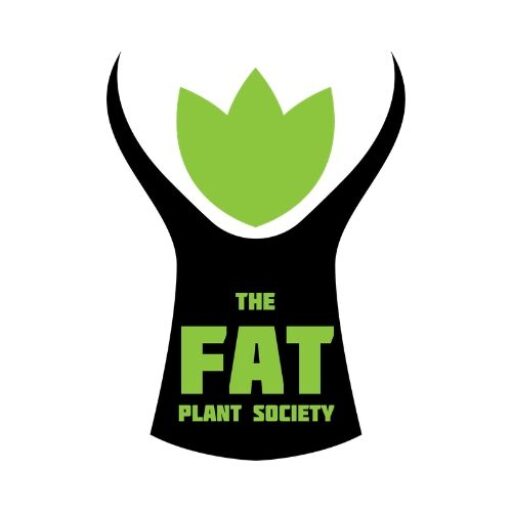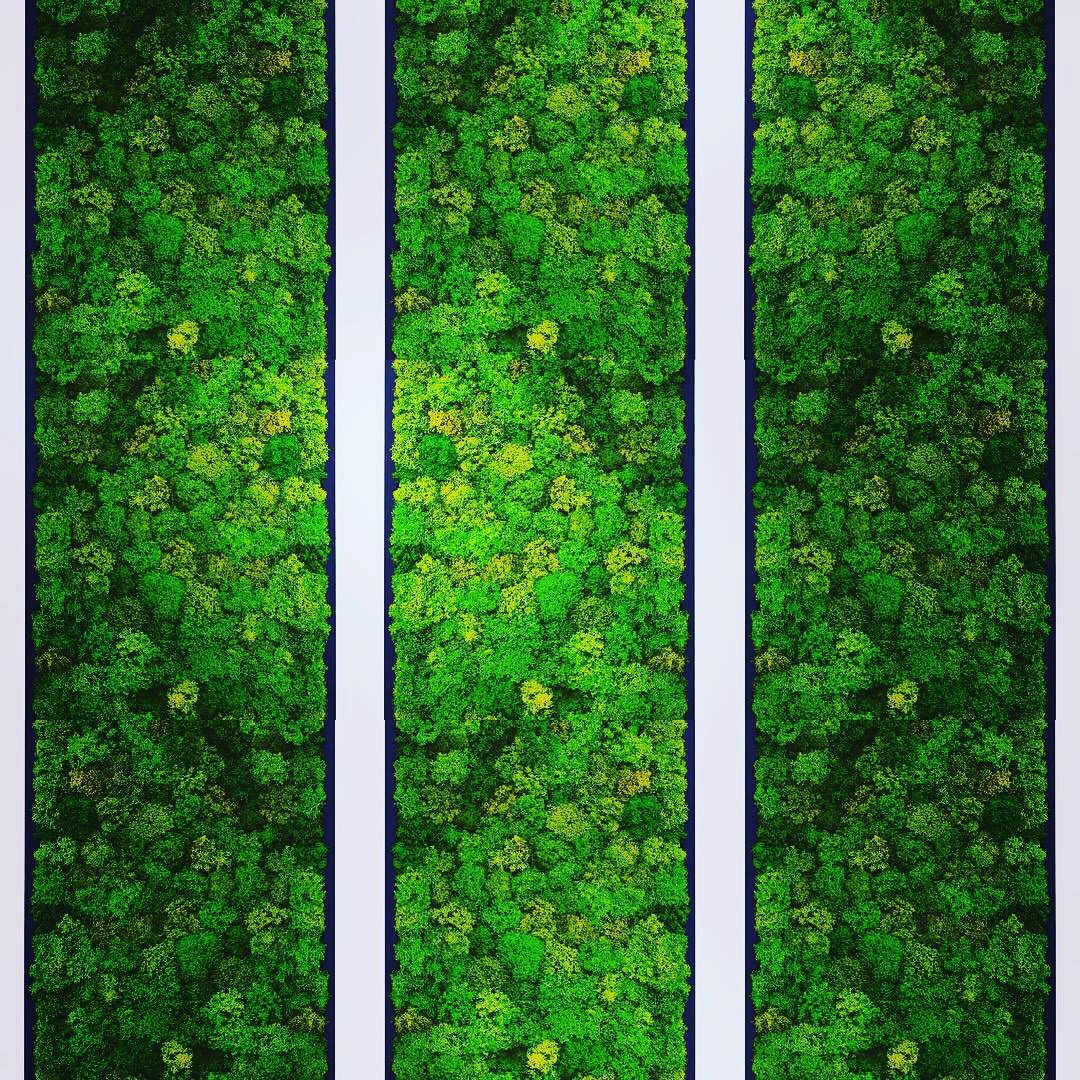
Biophilic design is good for your mental and physical well being and we will explain why. But before we do that, let’s break down the many “bio” terms that are currently being used in architecture, engineering, and design and define these terminologies and the role each plays in improving the spaces in which we live and work.
Biophilia is like any other “philia” meaning it is simply defined as an affinity–in the case of biophilia, it is an affinity for nature. Thus, we that love nature and find ourselves feeling fussy and out of sorts when we are away from nature are “biophiliacs.”
We will cover the core terms in this article but highly recommend a visit to The Biomimicry Institute, which is a wonderful organization replete with valuable resources, including a comprehensive Glossary of Terms.
While you are there, be sure to watch the 20-minute film on nature-inspired design (on the home page) featuring Janine Benyus (the mother of biomimicry) herself. You will want to watch the video for three reasons:
- It’s highly informative.
- It’s beautiful.
- That 20 minutes you will spend watching the video will literally reduce stress and make you feel better and here’s why…
An interdisciplinary team from Cornell University has found that as little as 10 minutes in a natural setting can help college students feel happier and lessen the effects of both physical and mental stress. That also applies to nature simulations and natural materials in built environments as well. We will share more on this study a little later in this article.
Biophilic Design
Biophilic Design uses the principles of biophilia (as coined by E.O. Wilson as “the urge to affiliate with other forms of life”) to create a natural and human-centered approach that improves our work and living spaces through benefits to our health and well-being.
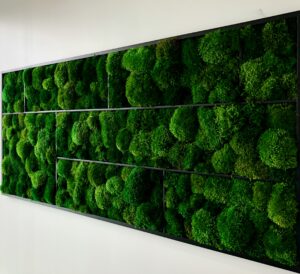
Avenue 82 in Overland Park, Kansas. Pillow Moss in Planter Box Design frame by The Fat Plant Society forIsom Collective.
At The Fat Plant Society, we use biophilia (in the form of real moss) in our biophilic designs that offer benefits that go far beyond cleaning the air of VOCs (volatile organic compounds) and dampening noise. Moss, a a real, natural material offers the benefits of attention restoration through fascination. We’re going to get academic for a moment because for us, it is these benefits that keep us rooted in using only natural materials:
“Succinctly, mental fatigue is associated with effortful voluntary attention and occurs because it takes considerable effort to stay focused. In contrast fascination is based on interest, resulting from process or content and it can be conceptualized along a dimension, from hard to soft: hard fascination is mainly concerned with activities, events, etc. whereas soft fascination has to do with environments, places; in both cases fascinating stimuli attract people and keep them from getting bored (Kaplan & Kaplan, 1989, p. 184). Unfortunately, everyday settings call for voluntary attention and the price paid is mental fatigue, which is the manifestation of the cumulative effect of distractions that must be inhibited for voluntary attention to function efficiently; mental fatigue indicates that the inhibitory mechanism is fatigued. By contrast, fascinating settings/patterns are inherently gripping and people do not spend energy in suppressing distracting stimuli because they do not have to pay attention to less than interesting stimuli.”
Source: Journal of Biourbanism 2014
Biomimicry
Biomimicry (and we always link to the work of Janine Benyus while simultaneously applauding the work of great guy Jamie Miller, founder of Biomimicry Frontiers) is the design and production of materials, structures, and systems that are modeled on biological entities and processes. Essentially, the larger picture regarding how to mimic nature (Mother Nature knows way more than we do) in everything from urban planning to building design.

Biomorphic Patterns and Materials. Moss Photo Credit: Alexandra Rhoades Photography.
Biomorphic Forms and Patterns

Jamie Miller, Founder of Biomimicry Frontiers uses the Calla Lily as the model for the water moving impeller.
Biomorphic forms and patterns are those that are made from and/or reflect the natural world. Designers, engineers and architects alike utilize naturally occurring patterns or shapes that call to mind nature and living organisms. At the Fat Plant Society, we use nature itself as our design material.
There are a number of creatures and shapes that we, as humans are highly familiar with whether we are consciously aware of them or not. From the Nautilus to the Fibonacci Sequence to the human body, we are inherently drawn to the forms and patterns of nature because not only are they natural, these bio designs make us feel better.
We’re seeing the trend toward biophilic design in so many places from large corporations and tech giants like Google, Microsoft and Amazon. For example, in Google’s Chicago office employees now have the option of adjusting the color temperature of the lighting to access light that simulates sunshine. As NBC News shared in their article, Microsoft built “treehouse meeting spaces,” while Amazon’s glass-paneled “Spheres” feature large living walls with hundreds of plant species.
Leaders of large corporations aren’t the only people implementing biophilic design for aesthetic appeal and to enhance well-being. Public space decision-makers are also implementing biophilic design and adding greenery to the design of libraries, hospitals, and retail stores (for storefront appeal and well-being) are also adopting biophilic design. In fact, we are creating a piece for a local library renovation to be completed in the spring of 2020.
“Greenery is fast becoming one of the hottest design trends, and it’s a perfect fit for retail. Studies show that greenery enhances the visual quality of a retail environment. This has many of the same effects that lighting does: increased perception of quality, higher levels of receptiveness to prices, and a more positive shopping experience in general.”
–
When we installed our first moss wall back in 2017, the term biophilic design, was not commonly used outside the industry and much of biophilic design focused soley on greenery.
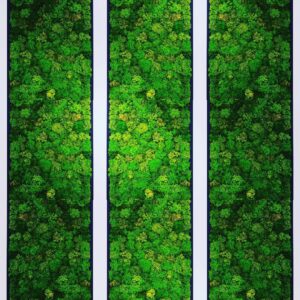
Tri-Panel Pillow Moss Design by The Fat Plant Society.
Today, we see biophilia and biophilic design influencing everything from the whole of the building design to the carpeting and furniture. We love the work of Coalesse. Not only does Coalesse offer a gorgeous line of office furnishings and rugs, they also have an outdoor line and living walls and partitions. As Coalesse notes in their article, “Today’s Top Organizations are Embracing Biophilic Design:”
“Tech companies aren’t the only institutions embracing this mindset– Washington Business Journal highlights a law office with a living wall and a rock bed anchoring a three-story staircase that links each of the floors. Meanwhile, Press Herald examines Nature Conservancy’s Maine headquarters, which features a carpet in the main work area that is deliberately representative of biophilic design – full of yellow and green shades and a natural gradation.”
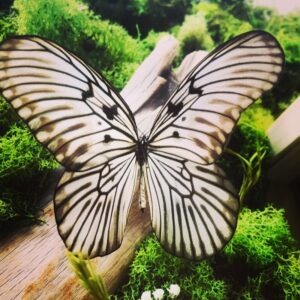
Butterfly by Oracle Kansas City complemented with parchment and Fat Plant Society Moss
And new publications and articles are emerging, many of which focus on biophilic design and implement biomimicry as well as biomorphic forms and patterns in both the build and design of new or renovated spaces.
Take CommArch for example. Not only does their site feature a beautiful digital edition of the publication (that has content on biophilic design) they work directly with architects and designers to create and curate content on the latest, important developments in sustainable building practices and biophilic design projects. We are big fans.
Now that we have our “bio” terminology straight, let’s take a look at why biophilic design makes us happy and we even have data to back that up. For that, we turn to again to Terramai who has produced a number of valuable papers on the connection between biophilia and happiness. In their article, titled, “How Biophilic Design is Making Humans Happier,” Terramai cited the 2011 study from the Journal of Happiness Studies that cites psychological health and happiness is directly related to contact with nature. The study finds, “changes in NR (nature relatedness aka nature in view) mediate the relationship between environmental education and changes in vitality.” This study builds on a previous study from the same journal that cemented the connection between biophilia and mental health.

Augustana University, South Dakota cares about the well-being of students and commissioned this branded piece for campus.
We were also darned excited to read the January 2020 article from Frontiers in Psychology (cited and expounded upon in the Cornell University article we referenced at the top of this piece) that focused on university student stress (heaven knows that’s a real and pressing issue). We strongly encourage you to read the full article as it’s fascinating and offers conclusions in the form of “time-dose and activity-type evidence for programs looking to use time in nature as a preventative measure for stress and mental health strain, and also demonstrates opportunities in six specific foci for more research in this area.”
So if you are feeling a little disconnected, a little frustrated or even angry, the data supports that surrounding yourself in nature can have significant benefits on your psychological well-being. If you don’t have time to take a forest bath every day (but if you can, please do, it is so incredibly good for you), introduce plants and other forms of greenery (such as zero maintenance moss designs) so as to bring the forest to you. The bottom line is that we humans are hard-wired to need nature to feel good or feel “right” as it were…
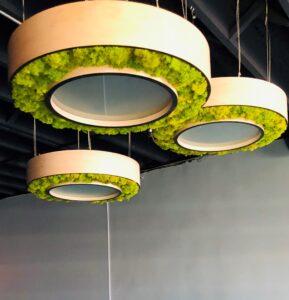
Sol Verde Lighting Fixtures. A collaborative design with HKn Design. The wood for these fixtures are actually re-purposed drum drops (fromthe manufacture of musical drums).
This wisdom, backed by research applies at home just as it applies to the workplace and frankly, anywhere from dark, windowless conference rooms to hospitals to hotels to restaurants. As author Emma Loewe notes in her article for mbg Planet (mind-body-green planet):
“…research by the World Green Building Council’s supported biophilic design’s ability to improve outlook, finding that families who visited the Akron Children’s Hospital were 67 percent more satisfied with their experience in the space after it underwent a green sweep. Van Vliet and others at the conference agreed that data collection like this is crucial. She also thinks that more collaboration between architects and scientists—particularly neuroscientists—is essential for spaces that promote well-being.”
Ms. Loewe notes that we human beings are complex–our senses go far beyond sight, sound, taste, and smell. In fact, we have 30 senses and how we design the spaces we inhabit has great bearing on all of our 30 senses. Loewe notes, that we actually consciously register/perceive much more than we know including, senses “like echolocation (how we perceive where we are in space related to the sounds around us) and thermoception (how we perceive the temperature of objects).”
The United States Green Building Council is on board with the concept of biophilic design for human wellness and well-being too. They are offering sessions on how biophilic design affects the human brain and human well-being and productivity. They also address the economic impact of these human behaviors is presented, and the value of moss walls as a specific biophilic design solution. We’re using their words here not, ours, the USGBC states, “Compared to some other biophilic design solutions, moss walls are affordable, require no light and no irrigation.”

UMB Bank wanted to make the dining hall at their offices a clean, welcoming environment for their team so they commissioned this piece by The Fat Plant Society that was installed in 2020.
Now that you understand the “bio” terms that are now part of the daily vernacular of architects, designers, and now students, you need not question the importance of the role that nature can play in your well-being invirtually any environment. The studies and research confirming the value of biophilic design will continue and at The Fat Plant Society, we’ll keep building green walls and developing more, unique ways to bring real nature into the spaces in which we live and work.
In the words of musician Barton Hartshorn, “The answers grow from the ground.”
As Always, Yours in the Love of All Things Green,
Kasey and Morten
